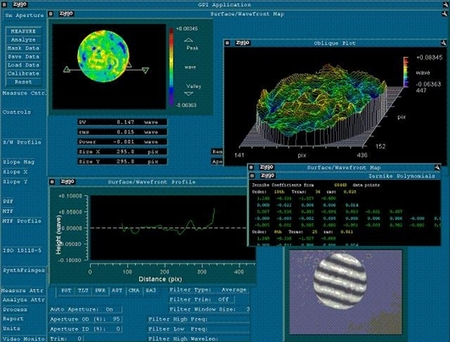Asphere Lenses
Hyperboloid Lenses
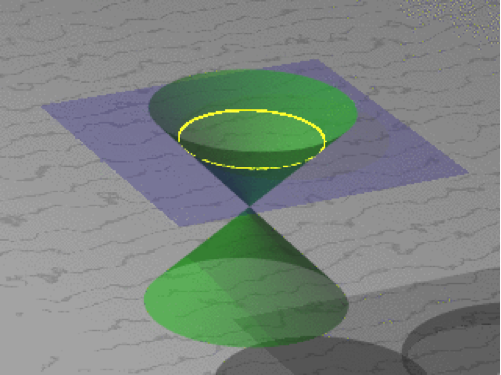
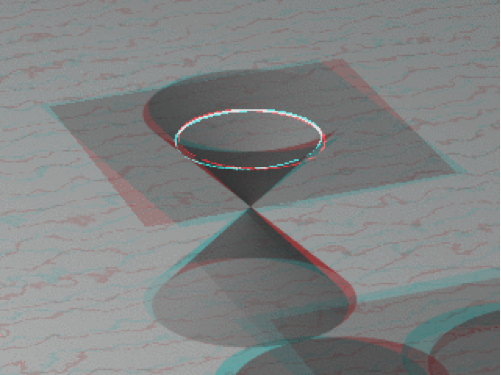
Along with the common spherical lens, OpticalRayTracer models another kind of lens, one with much better performance than the spherical, but one that is much more difficult to fabricate in glass.
When modeling a spherical lens, one need only specify one radius per sphere, as shown in the first graphic on this page. But when modeling a hyperboloidal curve, things are not so simple. Those properly trained in math will recall that circles, ellipses, parabolas and hyperbolas are all conic sections, or slices through a cone.
Examine the two graphic images to the right on this page. Click the top image repeatedly to cycle through the conic section images for a circle, ellipse, parabola and hyperbola. If you have a pair of anaglyphic eyeglasses (recommended), put them on and click the lower image in the same way for 3D views of the conic sections.
OpticalRayTracer relies on various derivative forms of the following equation to create/model hyperboloid lenses:

Where:
- y = Vertical coordinate for a given x argument.
- r = Lens sphere radius.
- d = Lens depth, as above.
- cf = Curvature factor, a lens shape fine-tuning prameter.
In OpticalRayTracer, the curvature factor has a meaningful range of 0 <= cf <= 0.25.
Equation (12), despite its central importance to the computations carried out, doesn't appear in the displayed form in OpticalRayTracer. It is instead the basis for a rather complex hyperboloid-line intersection routine used to process light paths during ray tracing.
Equation (12) is also restated as equation (13) below, used in OpticalRayTracer to draw hyperbolic lens profiles in the user interface:

Where:
- x = Horizontal coordinate for a given y argument.
- r = Lens sphere radius.
- d = Lens depth, as above.
- cf = Curvature factor, a lens shape fine-tuning prameter.
Here is an example lens design using the hyperboloid lens feature of OpticalRayTracer, similar to that provided in the help file. Start out with these settings:
In the "Configuration" tab:
- Number of Tracing Beams = 6 (the default)
- Diverging Beam Source = not selected
Create a lens with these traits:
- Symmetrical = selected
- Lens radius = 2 (the default)
- IOR = 1.52 (the default)
- X position = 0
- Y position = 0
- Left Sphere radius = 6 (applies to both radii)
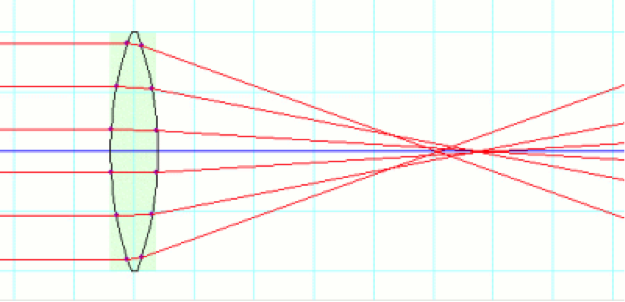
Examine the lens focal point. The short focal length chosen for this lens produces a rather severe spherical aberration, as shown in the accompanying image. Now select "Left Hyerboloid," which, because you have enabled the "symmetrical" mode, will change both lens surfaces at once.
Now enter 0.074 for "Left Curv. Fact.". This will optimize the lens for this focal length and almost completely eliminate the spherical aberration that was evident before. Those who are following along without running OpticalRayTracer should click the accompanying graphic to see the change.
Parabolic Lenses
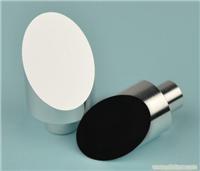
Off-axis paraboloids are excellent for collimation of a point source and for collecting of light from a distant source. The focal point is located outside of the collection area so that shadowing is eliminated.
These paraboloids are hand polished from large blanks of metal. They are finished to an accuracy of 1/10L and are provided with a measured interferogram. The back surface is ground so that when mounted the mirror normal bisects the angle between the focal axis and the collimated axis.
Perfect for collimating point sources.
Spherical and chromatic aberration free.
Standard diameters from 2.5 to 10.0 inches.
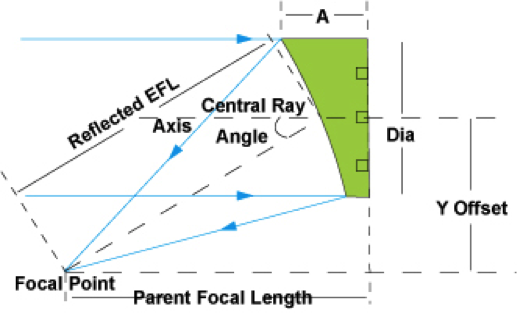
Toroidal Lenses
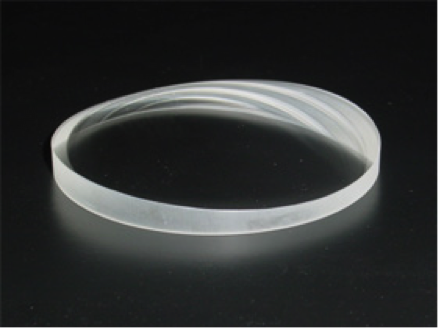
Toroidal lenses, also known as toric lenses, are lenses that have one or more toric surfaces. A toric surface is one having a maximum power in one meridian and a minimum power in a perpendicular meridian as defined by The Photonics Dictionary. CPG supplies toroidal lenses made of glass materials and plastic materials for use in laser applications, solar energy collector applications and other optical instrument applications.
Ellipsoidal Lenses
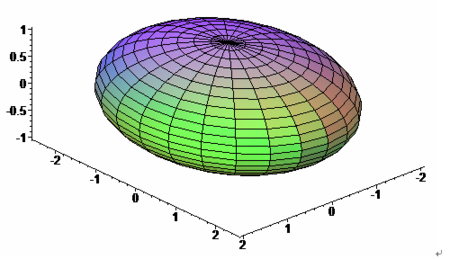
Ellipsoidal Lenses are usually used as reflectors, usually CPG optics have two ways of fabricating the glass substrate:
1.Traditional polish Such lens will be used in the image or laser systems to control the uniformity of the beam, then add condenser lens for higher performances, usually the coating layer deposited on the surface will help to gain more transmission or reflection, even partial functional result.
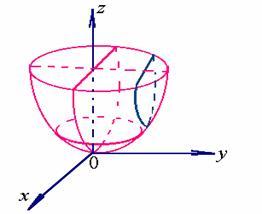
2.Molding CPG do not do molding by ourselves, but cooperated with a lot local company who professional doing this, we develop the mold and buy this mold from our molding supplier, and then send the mold to the molding factory. CPG has now over 10 years’ experiences of the quality control of the substrate, and then we apply coating on the lens, sometimes with the mount also.
Additionally, for plastic and mental lens, we will use SPDT machine or molding also, aimed to be a trustful supplier for our valued customer, we welcome our customer for authentication.
